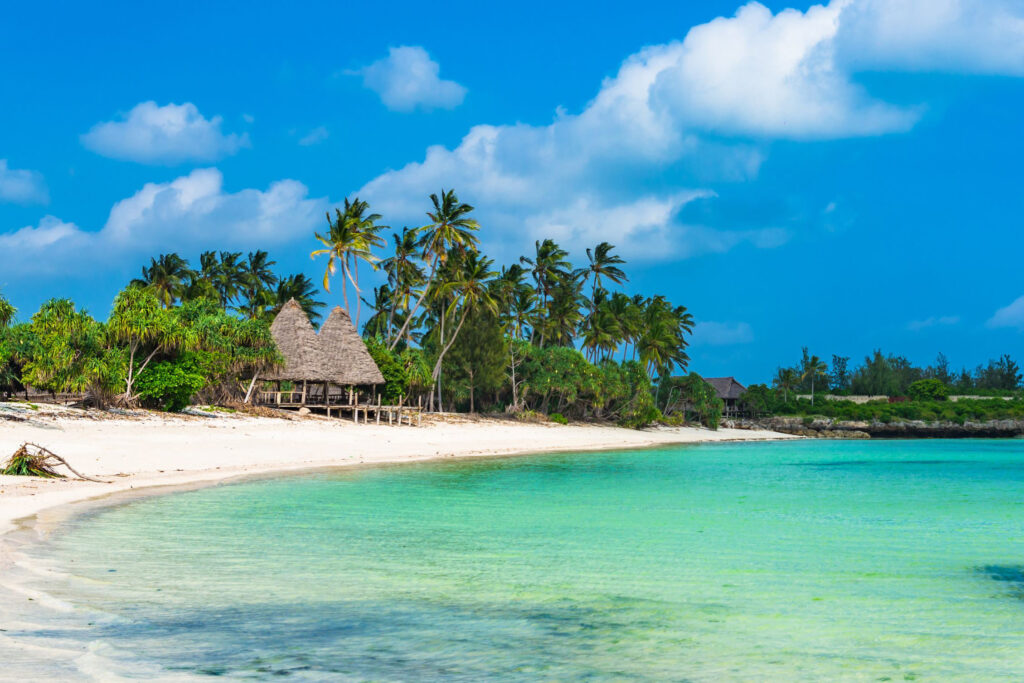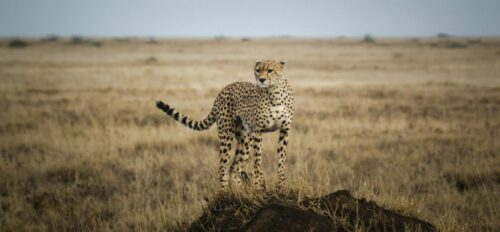When is the best time to travel to Tanzania?
You can enjoy a luxury Tanzania safari year-round, but July, August, and September are widely regarded as the best time to visit Tanzania. Summer is the dry season, temperatures are slightly milder, and you may have the opportunity to observe herds of wildebeest and zebra making harrowing river crossings during what’s known as the Great Migration.
However, Extraordinary Journeys safari specialists ardently advocate for visiting Tanzania during January and February. The weather is great and it’s calving season, a reliable time to see the Migration masses.
A word about weather: Bear in mind that this guide is founded on historical “norms” and trends based on our cumulative safari expertise. Weather patterns, average temperatures, rainfall, and the natural phenomena that react to seasonal changes are becoming less easy to predict as the climate warms.
Tanzania Climate & Weather Guide
Tanzania is situated just below the equator which means that the average year-round temperature fluctuates no more than 10 degrees—but that’s hardly the entire weather picture. There is an appreciable difference between Tanzania’s sea-level beaches and the higher elevations of the Rift Valley and the Serengeti plains.
Tanzania’s geography
Tanzania has a land area comparable to Texas and Arkansas combined. It stretches for 885 miles along the Indian Ocean which is backed by a narrow band of coastal lowland. Offshore, there’s a smattering of tropical islands which include Zanzibar, Pemba Island, and Mafia Island—to name a few.
The coastal lowlands give rise to Tanzania’s portion of the East Africa Rift Valley, which runs north-south through the country like two “branches.” Here, you encounter dramatic escarpments, volcanic peaks like Mount Kilimanjaro and Ol Donyo Lengai, and colorful alkaline lakes. The interior of Tanzania is characterized by a broad central plateau where you’ll find one of Africa’s best safari destinations: Serengeti National Park.
Average temperature in Tanzania
Tanzania lies just below the Equator, which means seasonal swings are less pronounced, especially in the north. However, peak southern hemisphere summer months (January and February) are generally warmer than winter (July and August).
In the Serengeti, January and February hover around 81°F. In July, it dips to an average of 77°F. In Zanzibar, respectively, the average temperatures are 89°F and 84°F.
Tanzania’s winter months (July and August) are the best time to combine safari with beach in Tanzania, but January and February are good too—if you don’t mind humidity at the coast.
Rain in Tanzania
Because we don’t see exaggerated differences in seasonal temperatures, when it comes to determining when is the best time to visit Tanzania (Great Migration aside), it’s more practical to consider precipitation.
Dry weather and slightly cooler temperatures typically occur from June through September. Sometime in October or early November, there’s a period of rain known as “the short rains.” At this time, precipitation collects across the day and then releases as a late afternoon or evening shower. In January and February, precipitation lets up before the long rains arrive, typically, in mid-March through to early May.
Although many people favor winter (June through September) as the best time to travel in Tanzania, safari-goers shouldn’t automatically reject travel during the wetter months—or, as we like to call it, season secret. As a trend, bouts of rainfall commonly arrive as an intense downpour and then promptly ease off or stop after an hour or so. What’s more, there are plenty of upsides, from emerald green landscapes to (virtually) crowd-free game viewing.
The best time to visit Serengeti National Park

Safaris in Serengeti National Park can be enjoyed year-round, but generally, July, August, and September are considered the best time to visit thanks to dramatic Great Migration river crossings and drier weather. However, it will be busy. And the landscape will be brown, parched, and potentially dusty.
January and February are fantastic in the Serengeti—months sandwiched between the short and long rains. At this time of year, concentrations of wildebeest and zebra gather on the plains to have their babies and graze these grasslands. Massive herds, adorable newborns, and predator action make it one of our favorite times to see the Great Migration.
Mid-March, April, May, and November are secret season in the Serengeti. Imagine, moody cobalt skies and green plains. The first two weeks of December are a sweet spot before festive season travelers arrive.
The best time to visit Zanzibar

For the best weather and blue skies, visit Zanzibar in June, July, August, September, and October. If you want a tan, it’s best to avoid the long rains in April and May. January and February are the hottest, but you’ll encounter humidity.
It’s possible to scuba dive in Zanzibar year-round. Prevailing winds in January and February can make water choppy but visibility is good. March is a sweet spot before the long rains arrive and when the wind dies down. July to October is warm and pleasant. December through April, spy manta rays and possibly whale sharks. September and October are known for migrating humpback and sperm whales in Nungwi.
When to visit Tanzania: a month-by-month guide

Visiting Tanzania in January
Festive season travelers will linger until the end of winter break, especially in popular “Northern Circuit” destinations (Serengeti, Ngorongoro Crater, Tarangire) and Zanzibar. The interior parks and plains are awash in greens, thanks to November’s rains. Migratory birds have returned from Europe and northern Africa creating a birdwatchers’ paradise. Temperatures are at their highest across the country. If you don’t mind some humidity at the coast, hit the beaches of Zanzibar, Pemba Island, or Mafia Island. The drier months of December, January, and February are a good time to hike Mount Kilimanjaro—fingers crossed for cloudless views.
Visiting Tanzania in February
February is a fantastic time to visit Tanzania on a safari, especially in the southern Serengeti where wildebeest are feeding in large concentrations on short grasses. Grazers are welcoming newborns and predators are keeping a watchful eye for an easy meal. Mobile camps are in full swing, allowing you to stay in the heart of the action. It’s a nice time of year to experience the Ngorongoro Crater, without the crowds.
Visiting Tanzania in March
March in the Serengeti is truly special. The plains can be quite dry in advance of the long rains, but calving is at its highest. With limited water sources, wildlife tends to gather where they find it, offering better chances to see more species in a concentrated area. Weather-wise, safari can be a bit of a mixed bag. The long rains don’t start on a timer, and can start as early as mid-March—or not.
Visiting Tanzania in April
The long rains start falling, which can be limiting (some camps in southern Tanzania will close), but secret season offers the benefit of thinner crowds, less dust, and perks like complimentary upgrades. You’ll still have the opportunity to head out on game drives, but heavy black soil can make certain areas slick or slow going—but guides know how to avoid them. Some safari camps, especially mobile camps in the Serengeti, close in April and May; staying in a lodge is the better choice. Pack a water-resistant jacket and a sense of adventure. The rains begin to revive the thirsty landscape, painting the scenery green again and carpeting swathes of the Serengeti with wildflower blooms.
Along the southern safari circuit (Katavi-Ruaha-Nyerere), the heat and humidity can be intolerable. Rain can cause some roads to become unpassable and many tented camps simply close for a few months.
Visiting Tanzania in May
May is still secret season in Tanzania. Weather-wise, it’s a toss-up. (It’s fall, after all!) You might get a rain shower, or not see a drop of rain at all. Moody skies contrast against the green landscape, making for great photography. The vegetation in Tarangire and Lake Manyara is lush, obscuring wildlife—not that they mind the added camouflage! (Consider an itinerary that combines the Serengeti and Ngorongoro Crater instead.)
As the long rains taper off (toward the end of May or even early June) and the plains begin to dry out, the Great Migration begins its journey northwest in search of sweet grass and water.
Visiting Tanzania in June
The long rains abate, and safari-goers enjoy spectacular scenery. High season has arrived and so have the rates. It’s a great time to climb Mount Kilimanjaro with mostly blue skies through to September. At the coast, the beach beckons.
At this time, parts of the northern Serengeti experience controlled burns. The location of the wildebeest can be difficult to predict in June. It’s best to speak directly with an Extraordinary Journeys safari specialist to maximize your odds of sighting a quintessential Migration moment.
June (through to October) also marks dry season in southern Tanzania—the best time to visit Katavi, Nyerere, and Ruaha National Parks. Days are warm, nights are cool.
Visiting Tanzania in July
July is peak season in Tanzania—and for good reason. The weather has hit an ideal compromise (dry and milder temperatures, though still warm). Mobile camps are in full swing, now strategically situated in the northern Serengeti to intercept Great Migration herds making their way to the Mara River to reach Kenya. Between July and August, the wildebeest move between the Serengeti and Kenya’s Maasai Mara, crossing the Mara River in staggering numbers. For travelers, river crossings rank among the most sought-after moments of the Great Migration, but are also entirely unpredictable.
The Ngorongoro Crater can get very crowded with line-ups at the gates—it’s best to stay on the rim so you can get a jump on those who won’t arrive until mid-morning.
With kids out on summer holidays, it’s a popular time for a family safari.
If you want to get away from the crowds, consider Tanzania’s remote and wild south: Ruaha National Park and Nyere National Park (formerly Selous).
Visiting Tanzania in August
Still peak season, we have another hideaway to tell you about. Head to Katavi National Park, one of the most remote and untouched safari destinations in East Africa, to catch a glimpse of massive herds of hippos and elephants crowded at dwindling dry-season water holes that they share with the resident crocodiles.
Otherwise, the Serengeti is teeming with wildlife—and travelers. It’s dry and temperatures are a bit lower than seasonal winter highs. Pack a layer for those early morning game drives.
Visiting Tanzania in September
September is a great time for chimp trekking in Mahale Mountains National Park. The primates have moved down to lower elevations meaning you don’t need to trek as far to see them. Plus, you’ll have more time to enjoy the other activities in the park including swimming, snorkeling, and boating on Lake Tanganyika.
Along the northern circuit (Serengeti, Ngorongoro Cater, Tarangire National Park, and Lake Manyara National Park), family travelers begin departing. The weather is still great: warm and dry.
Visiting Tanzania in October
In October, the temperature is beginning to rise. Weather-wise, October is a great time to enjoy safari in Tanzania. With school back in session, you’ll also benefit from a lack of crowds. And the Great Migration isn’t “over.” Some of the Great Migration herds might still be lingering in Kenya—and some may have splintered off and crossed back into Tanzania early—but there’s still plenty of resident game roaming the northern Serengeti.
These are the last few parched weeks before the relief of the short rains and the vegetation is thin, offering easier game sightings. It’s a particularly good time to visit Tarangire National Park. Lumbering amongst the baobab-studded landscape is one of the largest populations of African elephant sharing the scarce dry-season watering holes with game including East African oryx, wild dogs, and cheetah. In Ruaha National Park, it’s dry and hot. Thirsty wildlife concentrates around rivers.
Visiting Tanzania in November
The short rains arrive, reviving the sunbaked landscape. In a collective breath of relief, wildlife takes a long drink and then begins to disperse. Grasses thrive, and the bush thickens. It’s a great time to take a secret season safari, enjoying crowd-free game drives. Camps tend to be a bit quieter. In November, migratory birds from Europe and northern Africa begin arriving in East Africa, and you’ll continue to see them through early April.
Visiting Tanzania in December
December is a mix of both secret and peak season.
As in November, intermittent rains might continue, meaning fewer crowds and better value than other times of the year—at least through the first half of the month. Thanks to the short rains, the landscapes are painted green once again.
Festive season travelers arrive December 20 onward. Due to the popularity of visiting during festive season, booking your trip at least a year in advance is necessary for the best selection of lodgings.
Peruse luxury Tanzania safari itineraries

- Itinerary
Classic Migration Safari, by Private Vehicle
Private vehicles in prime migration areas across Tanzania and Kenya

- Itinerary
Manes & Plains: Ngorongoro Crater and the Serengeti
Explore the Serengeti’s Big Cat Country and Majesty of Ngorongoro

- Itinerary
Explore Northern Tanzania
Breathtaking Scenery and a Mobile Camp in the Serengeti
Keep reading about luxury Tanzania safaris

A Complete Guide to The Great Migration in Africa
Each year, the plains of East Africa host one of the world’s greatest wildlife…

Diving in Africa: Nine of the Best Diving Destinations for Your Safari
Africa is the perfect destination for divers and snorkelers alike. Discover our top 10…

Where to Take a Walking Safari in Tanzania
At Extraordinary Journeys, we like to push travelers just beyond their comfort zone—a…
Plan your Trip
Ready to start planning your own incredible adventure? We make the process stress-free and enjoyable.









